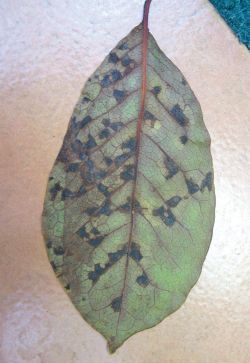Plant
Doctor Archive
Diseased
magnolias
  THE
foliage on some of my magnolias has become more and more discoloured
over recent months. It starts as a small blotch and expands to cover
large patches which go right through the leaf. Originally on only
one tree, it is now spreading to neighbouring trees. They are a
group of five magnolias, planted two years ago. Mature magnolias
planted a little further away don't seem to have been affected yet
and are growing well in the same conditions. THE
foliage on some of my magnolias has become more and more discoloured
over recent months. It starts as a small blotch and expands to cover
large patches which go right through the leaf. Originally on only
one tree, it is now spreading to neighbouring trees. They are a
group of five magnolias, planted two years ago. Mature magnolias
planted a little further away don't seem to have been affected yet
and are growing well in the same conditions.
 The
Magnolia soulangeana leaf you sent looks like it has been
affected by a bacterial disease. Generally, magnolias are not susceptible
to many pests or diseases, but varieties with Magnolia liliflora
in their parentage (as M. soulangeana varieties do) seem
susceptible to this leaf spotting at times. Bacterial diseases are
more prevalent in cool, wet weather when the leaves remain wet for
long periods. They also tend to be more common in nurseries where
plants are watered with overhead sprinklers. So it's possible the
plants were already infected when you planted them and it's the
wet weather this year that's caused such serious symptoms to appear.
It's also possible the disease has come from a nearby garden. The
Magnolia soulangeana leaf you sent looks like it has been
affected by a bacterial disease. Generally, magnolias are not susceptible
to many pests or diseases, but varieties with Magnolia liliflora
in their parentage (as M. soulangeana varieties do) seem
susceptible to this leaf spotting at times. Bacterial diseases are
more prevalent in cool, wet weather when the leaves remain wet for
long periods. They also tend to be more common in nurseries where
plants are watered with overhead sprinklers. So it's possible the
plants were already infected when you planted them and it's the
wet weather this year that's caused such serious symptoms to appear.
It's also possible the disease has come from a nearby garden.
Without lab analysis
it's difficult to tell exactly which disease is causing the problem,
but the good news is that in a "normal" spring with warmer, drier
conditions the plants may show no symptoms at all. There are many
broad spectrum fungicides available, but they have little effect
on the relatively few bacterial diseases we occasionally come across
in our gardens. For the home gardener, copper-based sprays are the
most practicable method of controlling bacterial diseases, so I
recommend you spray your magnolias with a product such as Champion
Copper or Copper Oxychloride. Unfortunately, copper sprays can be
washed off in heavy rain, so you may have to spray every 10 days
or so until the weather improves. Ideally, spray when the foliage
is dry, but not on a hot, sunny day, and take care to mix the spray
according to the label recommendations, as a stronger-than-recommended
dose may itself cause leaf damage.
To reduce the risk of
the disease overwintering in the soil, rake up the fallen leaves
in autumn and burn them.
Weekend
Gardener, Issue 163, 2005, Page 28
Reproduced with permission from the former Weekend Gardener magazine. The views expressed here are not necessarily those of the RNZIH.
|
 |
 |
|